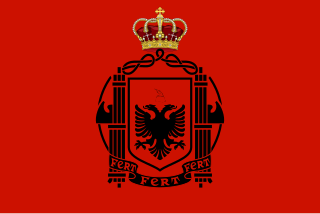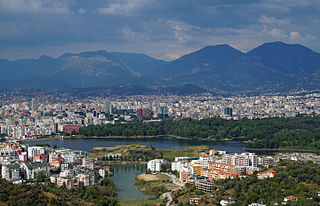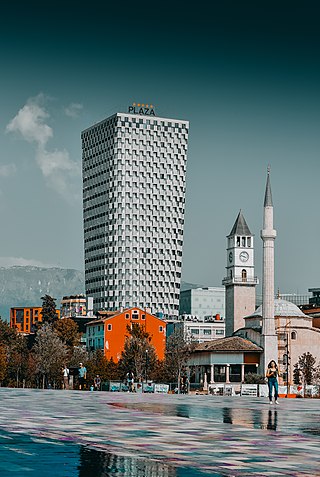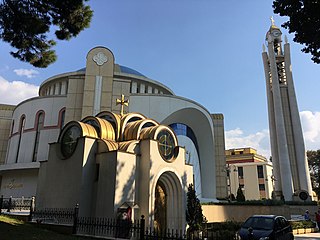During classical antiquity, Albania was home to several Illyrian tribes such as the Ardiaei, Albanoi, Amantini, Enchele, Taulantii and many others, but also Thracian and Greek tribes, as well as several Greek colonies established on the Illyrian coast. In the 3rd century BC, the area was annexed by Rome and became part of the Roman provinces of Dalmatia, Macedonia and Moesia Superior. Afterwards, the territory remained under Roman and Byzantine control until the Slavic migrations of the 7th century. It was integrated into the Bulgarian Empire in the 9th century.

Tirana is the capital and largest city of Albania. It is located in the centre of the country, enclosed by mountains and hills with Dajti rising to the east and a slight valley to the northwest overlooking the Adriatic Sea in the distance. It is among the wettest and sunniest cities in Europe, with 2,544 hours of sun per year.

Zog I was the leader of Albania from 1922 to 1939. At age 27, he first served as Albania's youngest ever prime minister (1922–1924), then as president (1925–1928), and finally as king (1928–1939).

Tourism in Albania has been a key element to the country's economic activity and is constantly developing. It is characterized by its rich archaeological and cultural heritage dating back to the classical period when Illyrians and Ancient Greeks inhabited the region. Over the course of history, the territory of Albania was occupied and populated by Romans, Byzantines, Venetians and Ottomans. Notably the country features unspoiled beaches, mountainous landscapes, traditional cuisine, archaeological artifacts, unique traditions, low prices and the wild atmosphere of the countryside.

The Italian colonists in Albania were Italians who, between the two World Wars, moved to Albania to colonize the Balkan country for the Kingdom of Italy.

The Skanderbeg Square is the main plaza in the centre of Tirana, Albania. The square is named after the Albanian national hero Gjergj Kastrioti Skënderbeu. The total area is about 40,000 square metres. The Skanderbeg Monument dominates the square.

Gustav von Myrdacz was an Austrian noble who was instrumental in organizing the Royal Albanian Army from the early 1920s to 1945. He was referred to in Albania as Gustav Mirdashi.

The Dëshmorët e Kombit Boulevard is a major thoroughfare in Tirana, Albania. It was initially designed by Armando Brasini in 1925. Brasini's master plan was later amended by Florestano di Fausto, and in 1939 by Gherardo Bosio following the Italian invasion of Albania.

The Zogu I Boulevard or Boulevard Zog I was the first and the only boulevard at that time and is a major boulevard in Tirana, Albania, named after Zog I of Albania, the King of Albania who ruled the country between 1925 and 1939.

The Grand Park of Tirana, or the Park on the Artificial Lake, is a 289 hectare public park situated on the southern part of Tirana, Albania, and administered by the Agency of Parks and Recreation of the Municipality of Tirana.

Tirana International Hotel is a hotel located in Tirana, Albania on the corner between central Skanderbeg Square and Zogu I Boulevard. Originally built in 1979 in a Soviet-era architectural style, it was named Hotel Tirana,. In 2001 the hotel was renovated by an Italian company and now it is a 4-star hotel. Tirana International has 168 rooms on 15 floors.

Ish-Blloku, commonly Blloku, is an upmarket area in Tirana, Albania. It widely known as an entertainment destination with its boutiques, shops, restaurants, trendy bars, pubs, and cafes. The area is part of the neighbourhood of Tirana e Re in southwestern Tirana. During the peak summer months, its trendy bars transfer along the Albanian Riviera.

Maritim Plaza Tirana is a luxury hotel in Tirana, Albania owned by German Maritim hotel chain. It is located on 28 Nëntori Street, near the Skanderbeg Square.

The Presidential Palace, formerly the Royal Palace and popularly known as the Palace of Brigades, is the official residence of the president of Albania. The palace was commissioned by King Zog I of the Albanians to serve as his main official residence.
Qazim Mulleti (1893–1956) was an Albanian politician, nationalist and mayor of Tirana from 1939 through 1940 and its prefect from 1942 to 1944.

The architecture of Albania is a reflection of Albania's historical and cultural heritage. The country's architecture was influenced by its location within the Mediterranean Basin and progressed over the course of history as it was once inhabited by numerous civilisations including the Illyrians, Ancient Greeks, Romans, Byzantines, Venetians, Ottomans as well as modern Austro-Hungarians and Italians. In addition, missionaries, invaders, colonisers and traders brought cultural changes that had a large profound effect on building styles as well as techniques.

The Mother Teresa Square is the second largest square in Tirana, Albania. It is named after the Albanian-born Indian Roman Catholic nun, missionary and Nobel Peace Prize laureate Mother Teresa.

There are many landmarks in Tirana, Albania some of which are of considerable historical or artistic interest. Many monuments and landmarks situated in Tirana, date back to the Illyrian, Roman, Greek and Ottoman periods.



















